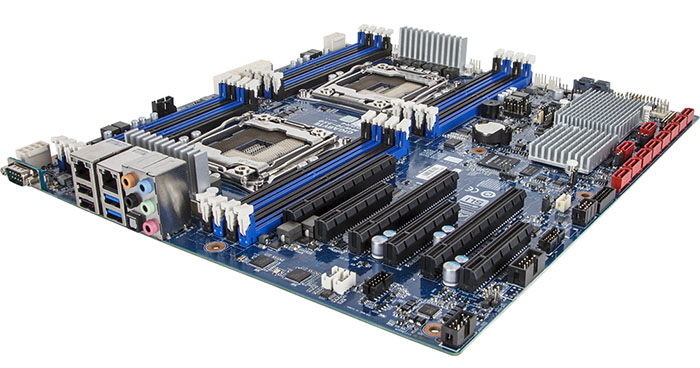Introduction
When enthusiasts begin to think of true high-end desktop machines the attention invariably heads towards CPUs and GPUs that pack in the most cores and shaders, respectively. That, for a consumer platform, is presently characterised by the Intel Core i7-5960X, housing 16 virtual cores, and the GeForce GTX Titan X graphics card from Nvidia.
Yet an increasing number of creatives and engineers seek more performance from the box underneath their work desks. In markets where processing speed has a direct correlation with profit, shoehorning in more power makes implicit sense. Welcome to the world of Intel Xeon.
The latest processors from this family, the E5-2600 v3 range, are architectural cousins to the Haswell-based 5960X. Though superceded on the desktop and mobile by Broadwell and Skylake architectures, the workstation segment typically lags about six months behind before transitioning to newer silicon.
Emblematic of the workstation environment is a dual-socket-bearing machine that can also accommodate a trio of professional graphics cards from either Nvidia or AMD. Up to 72 threads can be executed in parallel if there's budget for a couple of E5-2699 v3 processors sitting on top of a motherboard powered by the Intel C612 chipset.
Building a fine 2P Xeon-based motherboard is therefore good business practice for any manufacturer. Gigabyte, whose provenance lies with consumer boards first and foremost, has a considerable line-up of professional boards servicing this workstation market.
Here's the MW70-3S0 in its E-ATX glory. The busy PCB measures a standard 305mm by 330mm and therefore will fit into most larger chassis. The two LGA2011-3 sockets dominate the centre of the board. These are the same as their desktop counterparts in size and pin-count and have a square 80mm independent loading mechanism (ILM) mounting pitch. This means that coolers for the enthusiast X99 platform will work just fine.
What we do like is that, due to the board's size, the sockets are nicely spaced out - enough to enable two massive Noctua NH-D15 coolers to sit alongside each other. Both sockets can accept the 18-core, 36-thread 2699 v3 processor, or indeed any of the E5 v3 range. Power is sourced through the main 24-pin connector and a couple of 8-pin connectors on either side. Cooling is catered by five fan headers sensibly dotted around the board.
Alongside, eight DIMMs per processor offer support for up to 1,024GB of memory if quad-rank LRDIMMs are used, though we expect 32/64/128GB to be the more usual capacity. Memory bandwidth is often key in eking out extra performance in a number of applications but has historically been sacrificed to some degree as more DIMMs are added. Motherboard manufacturers sometimes reduce the maximum supported speed if the full gamut of DIMMs are populated. Gigabyte, however, enables all 16 slots to be filled while still running at 2,133MHz.
Surrounding the CPU sockets is technology we often see on consumer boards. Power regulation arrives from IR Digital PWM, IP PowlRstage ICs and long-lasting capacitors rated to at least 50,000 hours of usage. Further on down, there are three regular PCI and three full-length x16 PCIe slots, the latter supporting 3-way SLI or CrossFire. The exact speed of each PCIe slot depends upon the number of processors used, and rather than spell out the various permutations possible through multiple processors and switching, please refer to the linked diagram. The salient point is that two Haswell-EP chips will give you the opportunity of running three cards at a full x16 Gen3 PCIe.
Storage-wise the board natively supports 10 SATA 6Gbps, of which two ports can accept SATA disk-on-module for a flash-based boot, backup or general OS-holding drive. If you did take a peek at the MW70-3SO's chipset diagram above, you'll notice that one CPU's PCIe x8 lane, at the expense of graphics bandwidth, can be fed into an LSI SAS 3008 controller for 12Gbit/s (SAS-3) transfers. Gigabyte duly adds it here, with the controller interfacing with two mini-SAS HD that can expand out to 8 SAS ports.
Looking into the centre shows an ASPEED chip that's powered by an ARM v9 processor. Grabbing its bandwidth from the C612 southbridge, this chip's purpose is to enable the board to be used without a discrete video card.
What else? Gigabyte skimps somewhat on the audio, using the older ALC887 codec instead of the ALC1150. It's a small thing, for sure, yet it's present on much cheaper consumer boards. This rings more true when you consider the board is aimed at, according to Gigabyte, '3D modelling, video production or small scale scientific analysis environments', so folk who may want more-than-reasonable sound.
The back, meanwhile, shows the dual Intel Gigabit LAN ports, a couple of USB 3.0 and older USB 2.0. It's a shame that USB 3.1, now commonly seen on consumer motherboards, has yet to transition over to this workstation chipset.
We'd describe the MW70-3S0 as a lean workstation motherboard that eschews a bunch of extra features for a better layout.












